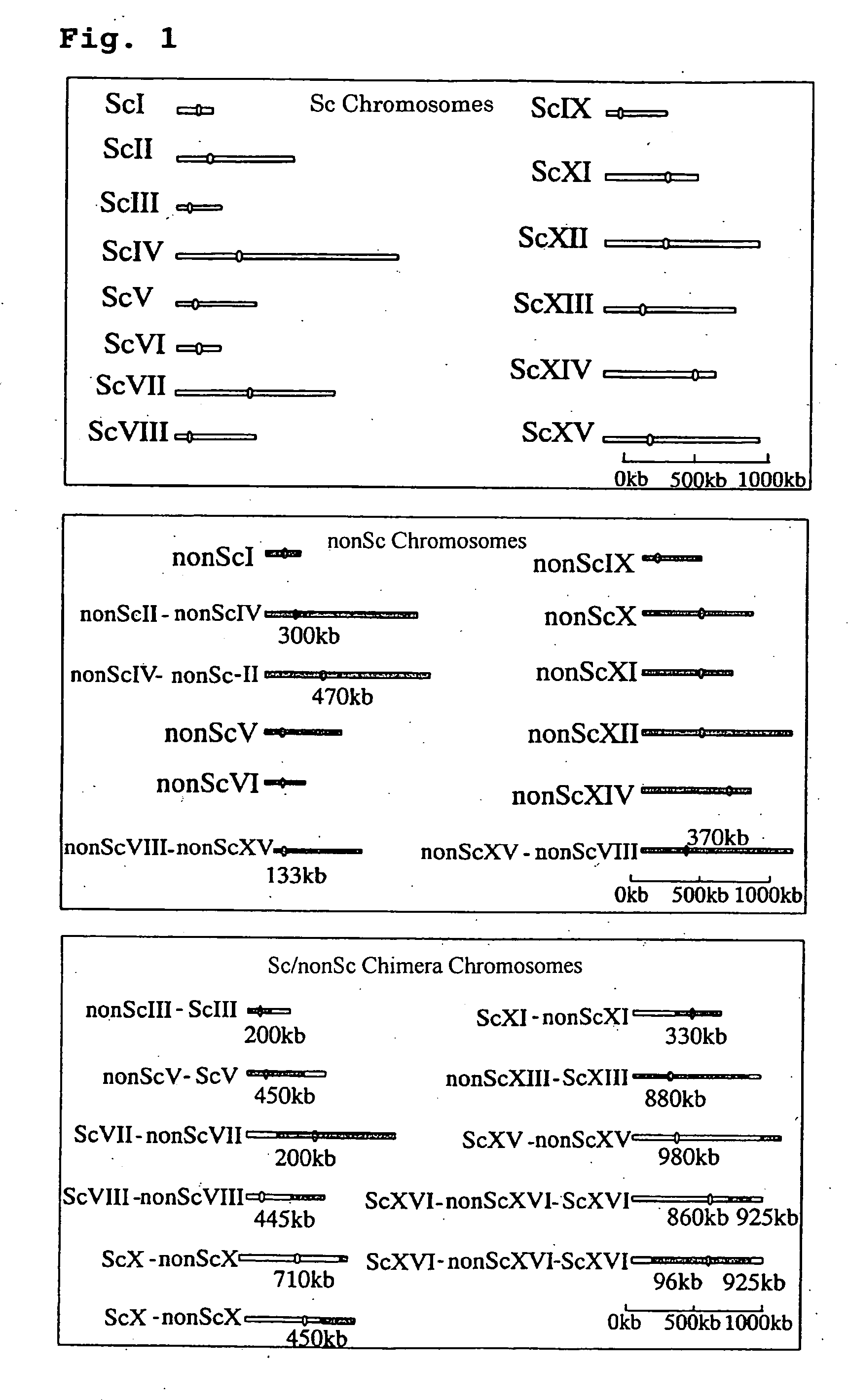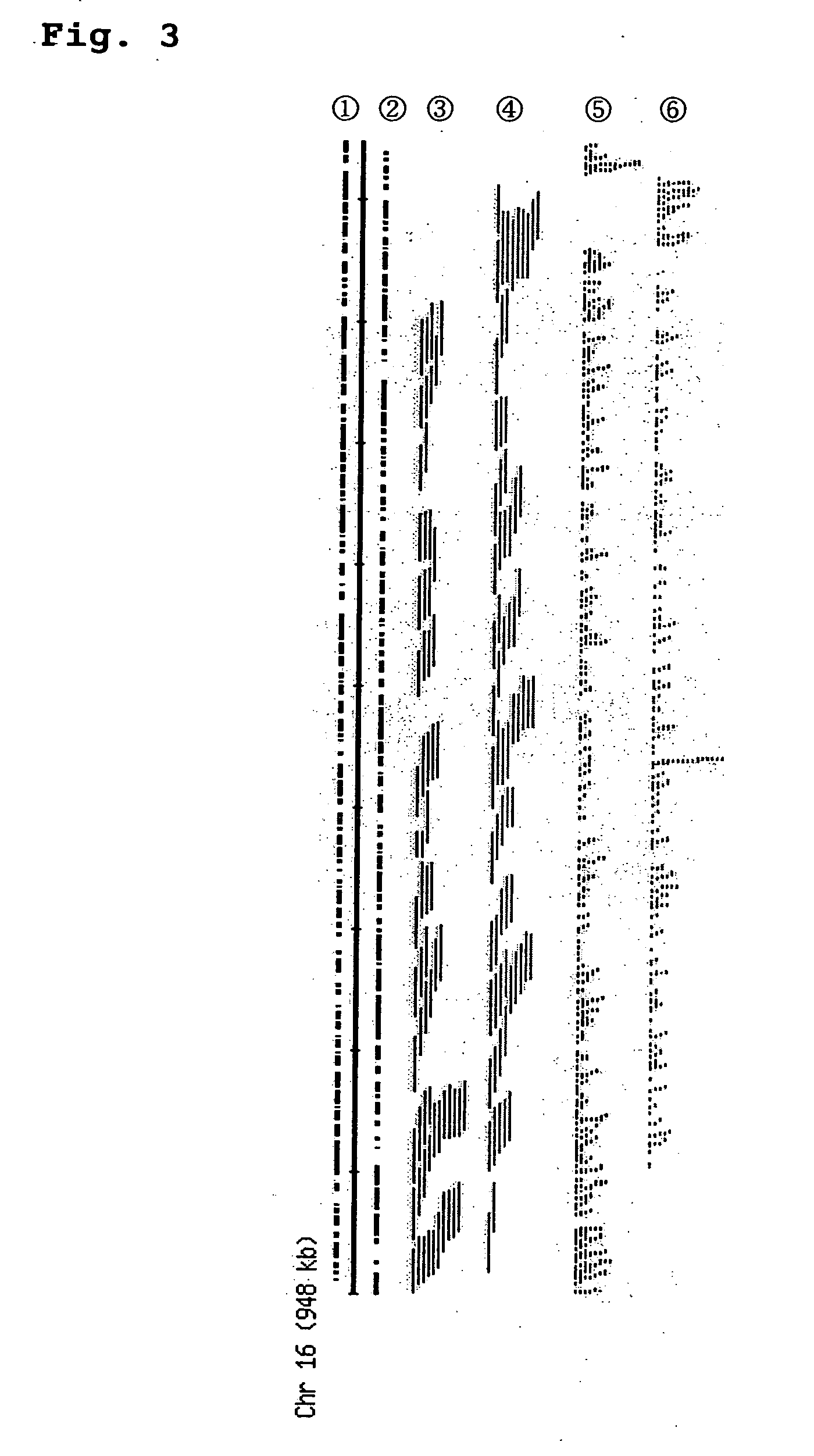Screening method for genes of brewing yeast
a technology of brewing yeast and gene expression, which is applied in the field of screening method of brewing yeast genes, can solve the problems of limiting the improvement of beer productivity and quality, retarding fermentation and/or deterioration of beer quality, and reducing the growth rate of yeast itself, so as to achieve the effect of improving productivity and quality
- Summary
- Abstract
- Description
- Claims
- Application Information
AI Technical Summary
Benefits of technology
Problems solved by technology
Method used
Image
Examples
example 1
Preparation of Chromosomal DNA of Saccharomyces pastorianus Weihenstephan 34 / 70 (Hereinafter, Abbreviated as Strain 34 / 70)
[0217] Preparation of chromosomal DNA was carried out by a method mentioned in “Yeast, a practical approach (IRL Press) 6.2.1 (pages 228-229)”, which was partially modified. Cells were inoculated and grown in 200 mL of YPD medium (2% glucose, 1% yeast extract and 2% polypeptone) at 30° C. until absorbance of the culture at 660 nm became 4. Cells were collected by centrifugation and washed with buffer A (50 mM sodium phosphate, 25 mM EDTA and 1% (v / v) β-mercaptoethanol; pH 7.5), resuspended in 25 mL of buffer A, and 7 mg of Zymolyase 100T (Seikagaku Kogyo) was added thereto and the mixture was mildly shaken at 37° C. for 60 minutes. To this was added 25 mL of buffer B (0.2M Tris-HCl, 80 mM EDTA and 1% SDS; pH 9.5), then the mixture was allowed to stand at 65° C. for 30 minutes, cooled on ice, mixed with 12 mL of 5M potassium acetate and allowed to stand on ice fo...
example 2
Preparation of a Shotgun Library
[0218] The concentration of the genome solution of strain 34 / 70 prepared in Example 1 was adjusted to 1 mg / mL using a TE buffer and 0.1 mL thereof was treated with a Hydroshear (manufactured by GeneMachines; speed: 6; cycle: 20) to fragment the genomic DNA. The ends of the genomic fragment were blunted using a DNA Blunting Kit (manufactured by Takara Shuzo), fractionated by 0.8% agarose electrophoresis, and a genomic fragment of 1.5 to 2.5 kb was excised from the gel and DNA was eluted. The DNA eluate was treated with phenol / chloroform and precipitated with ethanol to give a genome library insert. All the above insert and 0.5 μg of pUC 18 SmaI / BAP (manufactured by Amersham Biosciences) were subjected to ligation at 15° C. for 15 hours using T4 ligase (manufactured by Takara Shuzo).
[0219] The ligation reaction product was precipitated with ethanol and dissolved in 10 μL of a TE buffer. A ligation solution (1 μL) was inserted into 40 μL of Escherichia...
example 3
Preparation of a Cosmid Library
[0221] About 0.1 mg of the genome DNA obtained in Example 1 was partially digested with Sau3AI (manufactured by Takara Shuzo). Insertion of the fragment into a BamHI site of Super Cos I vector (manufactured by Stratagene) was carried out according to a manual. A ligated product prepared by this method was subjected to packaging using Gigapack III Gold (manufactured by Stratagene) and introduced into Escherichia coli XL1-Blue MR strain (manufactured by Stratagene) according to a manual. It was spread on an LB plate medium containing 0.1 mg / mL of ampicillin and incubated through the night at 37° C. The resulting transformants were cultured through the night at 37° C. in an LB medium (each well: 50 μL) containing 0.1 mg / mL of ampicillin using a 96-well titer plate, and then 50 μL of 50% glycerol solution was added thereto followed by stirring and the mixture was used as a glycerol stock.
PUM
| Property | Measurement | Unit |
|---|---|---|
| Fraction | aaaaa | aaaaa |
| Fraction | aaaaa | aaaaa |
| Fraction | aaaaa | aaaaa |
Abstract
Description
Claims
Application Information
 Login to View More
Login to View More - R&D
- Intellectual Property
- Life Sciences
- Materials
- Tech Scout
- Unparalleled Data Quality
- Higher Quality Content
- 60% Fewer Hallucinations
Browse by: Latest US Patents, China's latest patents, Technical Efficacy Thesaurus, Application Domain, Technology Topic, Popular Technical Reports.
© 2025 PatSnap. All rights reserved.Legal|Privacy policy|Modern Slavery Act Transparency Statement|Sitemap|About US| Contact US: help@patsnap.com



